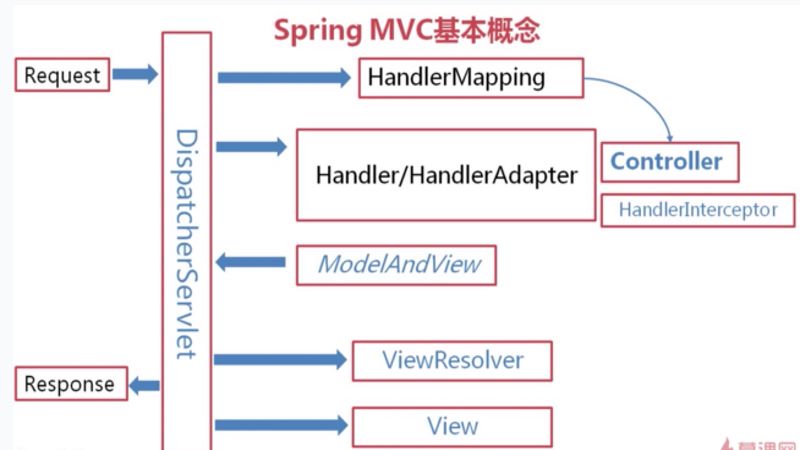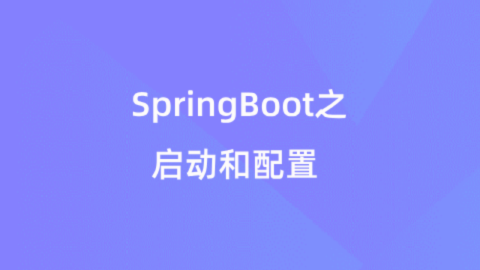文章申明:转载来源:https://blog.csdn.net/Number_oneEngineer/article/details/82775419
这里对SpringMVC框架进行一个简单的介绍:
springmvc是spring框架的一个模块,springmvc和spring无需通过中间整合层进行整合。
springmvc是一个基于mvc的web框架。
springmvc 表现层:方便前后端数据的传输
Spring MVC 拥有控制器,作用跟Struts类似,接收外部请求,解析参数传给服务层
MVC是指,C控制层,M模块层,V显示层这样的设计理念,而SSM框架里面SPRING MVC本身就是MVC框架,作用是帮助(某种意义上也可以 理解为约束)我们要按照MVC这样的设计来开发WEB项目,而另外两个框架spring主要是用作IOC,AOP等其他的一些设计原则。
至于mybatis是用来方便操作数据库的,所以他们都在MV里面,至于V指的是展示部分,一般是指JSP,freemarks这种前提其实,和SSM就没有太大的关系了
SpringMVC架构(MVC设计模式在BS系统下的应用)
springmvc项目架构图
Springmvc架构原理解析
1、发起请求到前端控制器(DispatcherServlet)
2、前端控制器请求HandlerMapping查找 Handler,可以根据xml配置、注解进行查找
3、处理器映射器HandlerMapping向前端控制器返回Handler
4、前端控制器调用处理器适配器去执行Handler
5、处理器适配器去执行Handler
6、Handler执行完成给适配器返回ModelAndView
7、处理器适配器向前端控制器返回ModelAndView,ModelAndView是springmvc框架的一个底层对象,包括 Model和view
8、前端控制器请求视图解析器去进行视图解析,根据逻辑视图名解析成真正的视图(jsp)
9、视图解析器向前端控制器返回View
10、前端控制器进行视图渲染,视图渲染将模型数据(在ModelAndView对象中)填充到request域
11、前端控制器向用户响应结果
组件:
1、前端控制器DispatcherServlet(不需要程序员开发)
作用接收请求,响应结果,相当于转发器,中央处理器。
有了DispatcherServlet减少了其它组件之间的耦合度。
2、处理器映射器HandlerMapping(不需要程序员开发)
作用:根据请求的url查找Handler
3、处理器适配器HandlerAdapter
作用:按照特定规则(HandlerAdapter要求的规则)去执行Handler
4、处理器Handler(需要程序员开发)
注意:编写Handler时按照HandlerAdapter的要求去做,这样适配器才可以去正确执行Handler
5、视图解析器View resolver(不需要程序员开发)
作用:进行视图解析,根据逻辑视图名解析成真正的视图(view)
6、视图View(需要程序员开发jsp)
View是一个接口,实现类支持不同的View类型(jsp、freemarker、pdf…)
SpringMVC学习笔记
一、SpringMVC基础入门,创建一个HelloWorld程序
1、首先,导入SpringMVC需要的jar包。
2、添加Web.xml配置文件中关于SpringMVC的配置
<!--configure the setting of springmvcDispatcherServlet and configure the mapping-->
<servlet>
<servlet-name>springmvc</servlet-name>
<servlet-class>org.springframework.web.servlet.DispatcherServlet</servlet-class>
<init-param>
<param-name>contextConfigLocation</param-name>
<param-value>classpath:springmvc-servlet.xml</param-value>
</init-param>
<!-- <load-on-startup>1</load-on-startup> -->
</servlet>
<servlet-mapping>
<servlet-name>springmvc</servlet-name>
<url-pattern>/</url-pattern>
</servlet-mapping>3、在src下添加springmvc-servlet.xml配置文件
<?xml version="1.0" encoding="UTF-8"?>
<beans xmlns="http://www.springframework.org/schema/beans"
xmlns:xsi="http://www.w3.org/2001/XMLSchema-instance"
xmlns:context="http://www.springframework.org/schema/context"
xmlns:mvc="http://www.springframework.org/schema/mvc"
xsi:schemaLocation="http://www.springframework.org/schema/beans http://www.springframework.org/schema/beans/spring-beans.xsd
http://www.springframework.org/schema/context http://www.springframework.org/schema/context/spring-context-4.1.xsd
http://www.springframework.org/schema/mvc http://www.springframework.org/schema/mvc/spring-mvc-4.1.xsd">
<!-- scan the package and the sub package -->
<context:component-scan base-package="test.SpringMVC"/>
<!-- don't handle the static resource -->
<mvc:default-servlet-handler />
<!-- if you use annotation you must configure following setting -->
<mvc:annotation-driven />
<!-- configure the InternalResourceViewResolver -->
<bean class="org.springframework.web.servlet.view.InternalResourceViewResolver"
id="internalResourceViewResolver">
<!-- 前缀 -->
<property name="prefix" value="/WEB-INF/jsp/" />
<!-- 后缀 -->
<property name="suffix" value=".jsp" />
</bean>
</beans>4、在WEB-INF文件夹下创建名为jsp的文件夹,用来存放jsp视图。创建一个hello.jsp,在body中添加“Hello World”。
5、建立包及Controller,如下所示
6、编写Controller代码
@Controller
@RequestMapping("/mvc")
public class mvcController {
@RequestMapping("/hello")
public String hello(){
return "hello";
}
}7、启动服务器,键入 http://localhost:8080/项目名/mvc/hello
二、配置解析
1、Dispatcherservlet
DispatcherServlet是前置控制器,配置在web.xml文件中的。拦截匹配的请求,Servlet拦截匹配规则要自已定义,把拦截下来的请求,依据相应的规则分发到目标Controller来处理,是配置spring MVC的第一步。
2、InternalResourceViewResolver
视图名称解析器
3、以上出现的注解
@Controller 负责注册一个bean 到spring 上下文中
@RequestMapping 注解为控制器指定可以处理哪些 URL 请求
三、SpringMVC常用注解
@Controller
负责注册一个bean 到spring 上下文中
@RequestMapping
注解为控制器指定可以处理哪些 URL 请求
@RequestBody
该注解用于读取Request请求的body部分数据,使用系统默认配置的HttpMessageConverter进行解析,然后把相应的数据绑定到要返回的对象上 ,再把HttpMessageConverter返回的对象数据绑定到 controller中方法的参数上
@ResponseBody
该注解用于将Controller的方法返回的对象,通过适当的HttpMessageConverter转换为指定格式后,写入到Response对象的body数据区
@ModelAttribute
在方法定义上使用 @ModelAttribute 注解:Spring MVC 在调用目标处理方法前,会先逐个调用在方法级上标注了@ModelAttribute 的方法
在方法的入参前使用 @ModelAttribute 注解:可以从隐含对象中获取隐含的模型数据中获取对象,再将请求参数 –绑定到对象中,再传入入参将方法入参对象添加到模型中
@RequestParam
在处理方法入参处使用 @RequestParam 可以把请求参 数传递给请求方法
@PathVariable
绑定 URL 占位符到入参
@ExceptionHandler
注解到方法上,出现异常时会执行该方法
@ControllerAdvice
使一个Contoller成为全局的异常处理类,类中用@ExceptionHandler方法注解的方法可以处理所有Controller发生的异常
四、自动匹配参数
//match automatically
@RequestMapping("/person")
public String toPerson(String name,double age){
System.out.println(name+" "+age);
return "hello";
}五、自动装箱
1、编写一个Person实体类
package test.SpringMVC.model;
public class Person {
public String getName() {
return name;
}
public void setName(String name) {
this.name = name;
}
public int getAge() {
return age;
}
public void setAge(int age) {
this.age = age;
}
private String name;
private int age;
}2、在Controller里编写方法
//boxing automatically
@RequestMapping("/person1")
public String toPerson(Person p){
System.out.println(p.getName()+" "+p.getAge());
return "hello";
}六、使用InitBinder来处理Date类型的参数
//the parameter was converted in initBinder
@RequestMapping("/date")
public String date(Date date){
System.out.println(date);
return "hello";
}
//At the time of initialization,convert the type "String" to type "date"
@InitBinder
public void initBinder(ServletRequestDataBinder binder){
binder.registerCustomEditor(Date.class, new CustomDateEditor(new SimpleDateFormat("yyyy-MM-dd"),
true));
}七、向前台传递参数
//pass the parameters to front-end
@RequestMapping("/show")
public String showPerson(Map<String,Object> map){
Person p =new Person();
map.put("p", p);
p.setAge(20);
p.setName("jayjay");
return "show";
}前台可在Request域中取到"p"
八、使用Ajax调用
//pass the parameters to front-end using ajax
@RequestMapping("/getPerson")
public void getPerson(String name,PrintWriter pw){
pw.write("hello,"+name);
}
@RequestMapping("/name")
public String sayHello(){
return "name";
}前台用下面的Jquery代码调用
$(function(){
$("#btn").click(function(){
$.post("mvc/getPerson",{name:$("#name").val()},function(data){
alert(data);
});
});
});九、在Controller中使用redirect方式处理请求
//redirect
@RequestMapping("/redirect")
public String redirect(){
return "redirect:hello";
}十、文件上传
1、需要导入两个jar包
2、在SpringMVC配置文件中加入
<!-- upload settings -->
<bean id="multipartResolver" class="org.springframework.web.multipart.commons.CommonsMultipartResolver">
<property name="maxUploadSize" value="102400000"></property>
</bean>方法代码
@RequestMapping(value="/upload",method=RequestMethod.POST)
public String upload(HttpServletRequest req) throws Exception{
MultipartHttpServletRequest mreq = (MultipartHttpServletRequest)req;
MultipartFile file = mreq.getFile("file");
String fileName = file.getOriginalFilename();
SimpleDateFormat sdf = new SimpleDateFormat("yyyyMMddHHmmss");
FileOutputStream fos = new FileOutputStream(req.getSession().getServletContext().getRealPath("/")+
"upload/"+sdf.format(new Date())+fileName.substring(fileName.lastIndexOf('.')));
fos.write(file.getBytes());
fos.flush();
fos.close();
return "hello";
}前台form表单
<form action="mvc/upload" method="post" enctype="multipart/form-data">
<input type="file" name="file"><br>
<input type="submit" value="submit">
</form>十一、使用@RequestParam注解指定参数的name
@Controller
@RequestMapping("/test")
public class mvcController1 {
@RequestMapping(value="/param")
public String testRequestParam(@RequestParam(value="id") Integer id,
@RequestParam(value="name")String name){
System.out.println(id+" "+name);
return "/hello";十二、RESTFul风格的SringMVC
1、RestController
@Controller
@RequestMapping("/rest")
public class RestController {
@RequestMapping(value="/user/{id}",method=RequestMethod.GET)
public String get(@PathVariable("id") Integer id){
System.out.println("get"+id);
return "/hello";
}
@RequestMapping(value="/user/{id}",method=RequestMethod.POST)
public String post(@PathVariable("id") Integer id){
System.out.println("post"+id);
return "/hello";
}
@RequestMapping(value="/user/{id}",method=RequestMethod.PUT)
public String put(@PathVariable("id") Integer id){
System.out.println("put"+id);
return "/hello";
}
@RequestMapping(value="/user/{id}",method=RequestMethod.DELETE)
public String delete(@PathVariable("id") Integer id){
System.out.println("delete"+id);
return "/hello";
}
}2、form表单发送put和delete请求
3、在web.xml中配置
<!-- configure the HiddenHttpMethodFilter,convert the post method to put or delete -->
<filter>
<filter-name>HiddenHttpMethodFilter</filter-name>
<filter-class>org.springframework.web.filter.HiddenHttpMethodFilter</filter-class>
</filter>
<filter-mapping>
<filter-name>HiddenHttpMethodFilter</filter-name>
<url-pattern>/*</url-pattern>
</filter-mapping>在前台可以用以下代码产生请求
<form action="rest/user/1" method="post">
<input type="hidden" name="_method" value="PUT">
<input type="submit" value="put">
</form>
<form action="rest/user/1" method="post">
<input type="submit" value="post">
</form>
<form action="rest/user/1" method="get">
<input type="submit" value="get">
</form>
<form action="rest/user/1" method="post">
<input type="hidden" name="_method" value="DELETE">
<input type="submit" value="delete">
</form>十三、返回json格式的字符串
1、导入以下jar包
2、方法代码
@Controller
@RequestMapping("/json")
public class jsonController {
@ResponseBody
@RequestMapping("/user")
public User get(){
User u = new User();
u.setId(1);
u.setName("jayjay");
u.setBirth(new Date());
return u;
}
}十四、异常的处理
1、处理局部异常(Controller内)
@ExceptionHandler
public ModelAndView exceptionHandler(Exception ex){
ModelAndView mv = new ModelAndView("error");
mv.addObject("exception", ex);
System.out.println("in testExceptionHandler");
return mv;
}
@RequestMapping("/error")
public String error(){
int i = 5/0;
return "hello";
}2、处理全局异常(所有Controller)
@ControllerAdvice
public class testControllerAdvice {
@ExceptionHandler
public ModelAndView exceptionHandler(Exception ex){
ModelAndView mv = new ModelAndView("error");
mv.addObject("exception", ex);
System.out.println("in testControllerAdvice");
return mv;3、另一种处理全局异常的方法
在SpringMVC配置文件中配置
<!-- configure SimpleMappingExceptionResolver -->
<bean class="org.springframework.web.servlet.handler.SimpleMappingExceptionResolver">
<property name="exceptionMappings">
<props>
<prop key="java.lang.ArithmeticException">error</prop>
</props>
</property>
</bean>error是出错页面
十五、设置一个自定义拦截器
1、创建一个MyInterceptor类,并实现HandlerInterceptor接口
public class MyInterceptor implements HandlerInterceptor {
@Override
public void afterCompletion(HttpServletRequest arg0,
HttpServletResponse arg1, Object arg2, Exception arg3)
throws Exception {
System.out.println("afterCompletion");
}
@Override
public void postHandle(HttpServletRequest arg0, HttpServletResponse arg1,
Object arg2, ModelAndView arg3) throws Exception {
System.out.println("postHandle");
}
@Override
public boolean preHandle(HttpServletRequest arg0, HttpServletResponse arg1,
Object arg2) throws Exception {
System.out.println("preHandle");
return true;
}2、在SpringMVC的配置文件中配置
<!-- interceptor setting -->
<mvc:interceptors>
<mvc:interceptor>
<mvc:mapping path="/mvc/**"/>
<bean class="test.SpringMVC.Interceptor.MyInterceptor"></bean>
</mvc:interceptor>
</mvc:interceptors>3、拦截器执行顺序
十六、表单的验证(使用Hibernate-validate)及国际化
1、导入Hibernate-validate需要的jar包
(未选中不用导入)
2、编写实体类User并加上验证注解
public class User {
public int getId() {
return id;
}
public void setId(int id) {
this.id = id;
}
public String getName() {
return name;
}
public void setName(String name) {
this.name = name;
}
public Date getBirth() {
return birth;
}
public void setBirth(Date birth) {
this.birth = birth;
}
@Override
public String toString() {
return "User [id=" + id + ", name=" + name + ", birth=" + birth + "]";
}
private int id;
@NotEmpty
private String name;
@Past
@DateTimeFormat(pattern="yyyy-MM-dd")
private Date birth;
}ps:@Past表示时间必须是一个过去值
3、在jsp中使用SpringMVC的form表单
<form:form action="form/add" method="post" modelAttribute="user">
id:<form:input path="id"/><form:errors path="id"/><br>
name:<form:input path="name"/><form:errors path="name"/><br>
birth:<form:input path="birth"/><form:errors path="birth"/>
<input type="submit" value="submit">
</form:form>ps:path对应name
4、Controller中代码
@Controller
@RequestMapping("/form")
public class formController {
@RequestMapping(value="/add",method=RequestMethod.POST)
public String add(@Valid User u,BindingResult br){
if(br.getErrorCount()>0){
return "addUser";
}
return "showUser";
}
@RequestMapping(value="/add",method=RequestMethod.GET)
public String add(Map<String,Object> map){
map.put("user",new User());
return "addUser";
}
}ps:
1.因为jsp中使用了modelAttribute属性,所以必须在request域中有一个"user".
2.@Valid 表示按照在实体上标记的注解验证参数
3.返回到原页面错误信息回回显,表单也会回显
5、错误信息自定义
在src目录下添加locale.properties
NotEmpty.user.name=name can't not be empty
Past.user.birth=birth should be a past value
DateTimeFormat.user.birth=the format of input is wrong
typeMismatch.user.birth=the format of input is wrong
typeMismatch.user.id=the format of input is wrong在SpringMVC配置文件中配置
<!-- configure the locale resource -->
<bean id="messageSource" class="org.springframework.context.support.ResourceBundleMessageSource">
<property name="basename" value="locale"></property>
</bean>6、国际化显示
在src下添加locale_zh_CN.properties
username=账号
password=密码
locale.properties中添加
username=user name
password=password创建一个locale.jsp
在SpringMVC中配置
<!-- make the jsp page can be visited -->
<mvc:view-controller path="/locale" view-name="locale"/>让locale.jsp在WEB-INF下也能直接访问
最后,访问locale.jsp,切换浏览器语言,能看到账号和密码的语言也切换了
十七、压轴大戏–整合SpringIOC和SpringMVC
1、创建一个test.SpringMVC.integrate的包用来演示整合,并创建各类
2、User实体类
public class User {
public int getId() {
return id;
}
public void setId(int id) {
this.id = id;
}
public String getName() {
return name;
}
public void setName(String name) {
this.name = name;
}
public Date getBirth() {
return birth;
}
public void setBirth(Date birth) {
this.birth = birth;
}
@Override
public String toString() {
return "User [id=" + id + ", name=" + name + ", birth=" + birth + "]";
}
private int id;
@NotEmpty
private String name;
@Past
@DateTimeFormat(pattern="yyyy-MM-dd")
private Date birth;
}3、UserService类
@Component
public class UserService {
public UserService(){
System.out.println("UserService Constructor...\n\n\n\n\n\n");
}
public void save(){
System.out.println("save");
}
}4、UserController
@Controller
@RequestMapping("/integrate")
public class UserController {
@Autowired
private UserService userService;
@RequestMapping("/user")
public String saveUser(@RequestBody @ModelAttribute User u){
System.out.println(u);
userService.save();
return "hello";
}
}5、Spring配置文件
在src目录下创建SpringIOC的配置文件applicationContext.xml
<?xml version="1.0" encoding="UTF-8"?>
<beans xmlns="http://www.springframework.org/schema/beans"
xmlns:xsi="http://www.w3.org/2001/XMLSchema-instance"
xsi:schemaLocation="http://www.springframework.org/schema/beans
http://www.springframework.org/schema/beans/spring-beans.xsd
http://www.springframework.org/schema/util
http://www.springframework.org/schema/util/spring-util-4.0.xsd
http://www.springframework.org/schema/context
http://www.springframework.org/schema/context/spring-context.xsd
"
xmlns:util="http://www.springframework.org/schema/util"
xmlns:p="http://www.springframework.org/schema/p"
xmlns:context="http://www.springframework.org/schema/context"
>
<context:component-scan base-package="test.SpringMVC.integrate">
<context:exclude-filter type="annotation"
expression="org.springframework.stereotype.Controller"/>
<context:exclude-filter type="annotation"
expression="org.springframework.web.bind.annotation.ControllerAdvice"/>
</context:component-scan>
</beans>在Web.xml中添加配置
<!-- configure the springIOC -->
<listener>
<listener-class>org.springframework.web.context.ContextLoaderListener</listener-class>
</listener>
<context-param>
<param-name>contextConfigLocation</param-name>
<param-value>classpath:applicationContext.xml</param-value>
</context-param>6、在SpringMVC中进行一些配置,防止SpringMVC和SpringIOC对同一个对象的管理重合
<!-- scan the package and the sub package -->
<context:component-scan base-package="test.SpringMVC.integrate">
<context:include-filter type="annotation"
expression="org.springframework.stereotype.Controller"/>
<context:include-filter type="annotation"
expression="org.springframework.web.bind.annotation.ControllerAdvice"/>
</context:component-scan>十八、SpringMVC详细运行流程图

十九、SpringMVC运行原理
1、用户发送请求至前端控制器DispatcherServlet
2、DispatcherServlet收到请求调用HandlerMapping处理器映射器。
3、处理器映射器根据请求url找到具体的处理器,生成处理器对象及处理器拦截器(如果有则生成)一并返回给DispatcherServlet。
4、DispatcherServlet通过HandlerAdapter处理器适配器调用处理器
5、执行处理器(Controller,也叫后端控制器)。
6、Controller执行完成返回ModelAndView
7、HandlerAdapter将controller执行结果ModelAndView返回给DispatcherServlet
8、DispatcherServlet将ModelAndView传给ViewReslover视图解析器
9、ViewReslover解析后返回具体
10、DispatcherServlet对View进行渲染视图(即将模型数据填充至视图中)。
11、DispatcherServlet响应用户
二十、SpringMVC与struts2的区别
1、springmvc基于方法开发的,struts2基于类开发的。
springmvc将url和controller里的方法映射。
映射成功后springmvc生成一个Handler对象,对象中只包括了一个method。方法执行结束,形参数据销毁。
springmvc的controller开发类似web service开发。
2、 springmvc可以进行单例开发,并且建议使用单例开发,struts2通过类的成员变量接收参数,无法使用单例,只能使用多例。
3、经过实际测试,struts2速度慢,在于使用struts标签,如果使用struts建议使用jstl。






老师讲得好好啊,谢谢老师
涨知识了